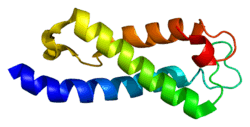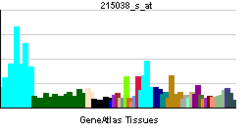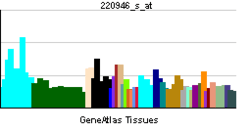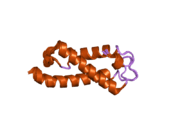SETD2
SET domain containing 2 is an enzyme that in humans is encoded by the SETD2 gene.[1][2][3]
Function
SETD2 protein is a histone methyltransferase that is specific for lysine-36 of histone H3, and methylation of this residue is associated with active chromatin. This protein also contains a novel transcriptional activation domain and has been found associated with hyperphosphorylated RNA polymerase II.[3]
Clinical significance
The SETD2 gene is located on the short arm of chromosome 3 and has been shown to play a tumour suppressor role in human cancer.[4]
Interactions
SETD2 has been shown to interact with Huntingtin.[5] Huntington's disease (HD), a neurodegenerative disorder characterized by loss of striatal neurons, is caused by an expansion of a polyglutamine tract in the HD protein huntingtin. SETD2 belongs to a class of huntingtin interacting proteins characterized by WW motifs. [3]
References
- ↑ Sun XJ, Wei J, Wu XY, Hu M, Wang L, Wang HH, Zhang QH, Chen SJ, Huang QH, Chen Z (Oct 2005). "Identification and characterization of a novel human histone H3 lysine 36-specific methyltransferase". J Biol Chem 280 (42): 35261–71. doi:10.1074/jbc.M504012200. PMID 16118227.
- ↑ Rega S, Stiewe T, Chang DI, Pollmeier B, Esche H, Bardenheuer W, Marquitan G, Putzer BM (Jul 2001). "Identification of the full-length huntingtin- interacting protein p231HBP/HYPB as a DNA-binding factor". Mol Cell Neurosci 18 (1): 68–79. doi:10.1006/mcne.2001.1004. PMID 11461154.
- ↑ 3.0 3.1 3.2 "Entrez Gene: SETD2 SET domain containing 2".
- ↑ Al Sarakbi W, Sasi W, Jiang WG, Roberts T, Newbold RF, Mokbel K (2009). "The mRNA expression of SETD2 in human breast cancer: correlation with clinico-pathological parameters". BMC Cancer 9: 290. doi:10.1186/1471-2407-9-290. PMC 3087337. PMID 19698110.
- ↑ Faber PW, Barnes GT, Srinidhi J, Chen J, Gusella JF, MacDonald ME (September 1998). "Huntingtin interacts with a family of WW domain proteins". Hum. Mol. Genet. 7 (9): 1463–74. doi:10.1093/hmg/7.9.1463. PMID 9700202.
Further reading
- Faber PW, Barnes GT, Srinidhi J et al. (1998). "Huntingtin interacts with a family of WW domain proteins". Hum. Mol. Genet. 7 (9): 1463–74. doi:10.1093/hmg/7.9.1463. PMID 9700202.
- Passani LA, Bedford MT, Faber PW et al. (2000). "Huntingtin's WW domain partners in Huntington's disease post-mortem brain fulfill genetic criteria for direct involvement in Huntington's disease pathogenesis". Hum. Mol. Genet. 9 (14): 2175–82. doi:10.1093/hmg/9.14.2175. PMID 10958656.
- Zhang QH, Ye M, Wu XY et al. (2001). "Cloning and functional analysis of cDNAs with open reading frames for 300 previously undefined genes expressed in CD34+ hematopoietic stem/progenitor cells". Genome Res. 10 (10): 1546–60. doi:10.1101/gr.140200. PMC 310934. PMID 11042152.
- Nagase T, Kikuno R, Hattori A et al. (2001). "Prediction of the coding sequences of unidentified human genes. XIX. The complete sequences of 100 new cDNA clones from brain which code for large proteins in vitro". DNA Res. 7 (6): 347–55. doi:10.1093/dnares/7.6.347. PMID 11214970.
- Strausberg RL, Feingold EA, Grouse LH et al. (2003). "Generation and initial analysis of more than 15,000 full-length human and mouse cDNA sequences". Proc. Natl. Acad. Sci. U.S.A. 99 (26): 16899–903. doi:10.1073/pnas.242603899. PMC 139241. PMID 12477932.
- Ota T, Suzuki Y, Nishikawa T et al. (2004). "Complete sequencing and characterization of 21,243 full-length human cDNAs". Nat. Genet. 36 (1): 40–5. doi:10.1038/ng1285. PMID 14702039.
- Beausoleil SA, Jedrychowski M, Schwartz D et al. (2004). "Large-scale characterization of HeLa cell nuclear phosphoproteins". Proc. Natl. Acad. Sci. U.S.A. 101 (33): 12130–5. doi:10.1073/pnas.0404720101. PMC 514446. PMID 15302935.
- Gerhard DS, Wagner L, Feingold EA et al. (2004). "The status, quality, and expansion of the NIH full-length cDNA project: the Mammalian Gene Collection (MGC)". Genome Res. 14 (10B): 2121–7. doi:10.1101/gr.2596504. PMC 528928. PMID 15489334.
- Li M, Phatnani HP, Guan Z et al. (2006). "Solution structure of the Set2-Rpb1 interacting domain of human Set2 and its interaction with the hyperphosphorylated C-terminal domain of Rpb1". Proc. Natl. Acad. Sci. U.S.A. 102 (49): 17636–41. doi:10.1073/pnas.0506350102. PMC 1308900. PMID 16314571.
- Lim J, Hao T, Shaw C et al. (2006). "A protein-protein interaction network for human inherited ataxias and disorders of Purkinje cell degeneration". Cell 125 (4): 801–14. doi:10.1016/j.cell.2006.03.032. PMID 16713569.
- Olsen JV, Blagoev B, Gnad F et al. (2006). "Global, in vivo, and site-specific phosphorylation dynamics in signaling networks". Cell 127 (3): 635–48. doi:10.1016/j.cell.2006.09.026. PMID 17081983.
| |||||||||




